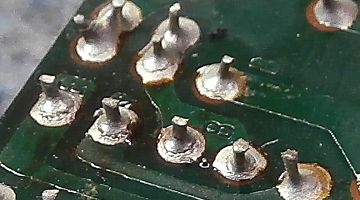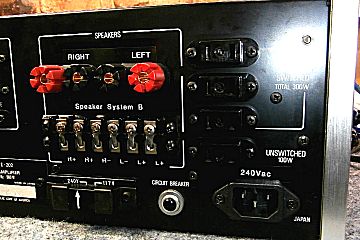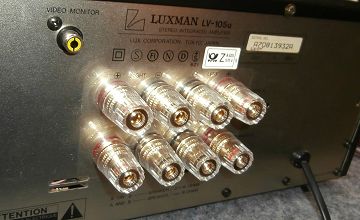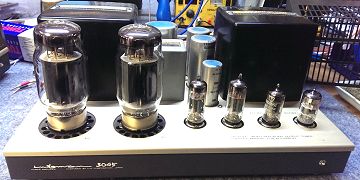 |
 |
 |
|
Do we fix vintage audio units? Your questions about repairs and refurbs for classic units answered here. |
Back to FAQ
|
Classic Audio Components. Yes, we do repair and refurbish and also upgrade classic audio units – but that doesn't mean just any old thing. One man's trash is another man's treasure – and there's a big difference between a timeless classic that's worthy of restoration and something that's inexplicably avoided the landfill! So, what's good to own / buy / refurbish? Amps, speakers, turntables and tuners, especially from the 1970's (or thereabouts) will usually fix up very nicely (unless of course, they're very low-end and clapped out totally!). Why especially 1970's vintage? This was a time when a predominantly Japanese Hi Fi industry reached a peak of sophistication and quality that's rarely matched today (unless you spend a lot of money). By the 1980's however, most of the great Japanese brands, seduced by turnover, began cutting each other's throats for floor space amongst the T.V.s and other appliances in discount and department stores. It was in the '80's that we saw the emergence of the ubiquitous 'tower system'... two tinted glass doors and no-name speakers with matching 'woodgrain' plastic veneer -- amp, tuner, cassette deck, graphic equaliser and a turntable with a base that seemed to made out of the same stuff as the lid... Only $899.00!!! Technological and economic factors had forced them embrace the culture of planned obsolescence. Metal, wood and glass gave way to plastic -- discrete components gave way to cheap I.C.s that went out of production almost as fast as they appeared and spare parts disappeared soon as they became obsolete. There were still some good things made in the 1980's but they were more the exception than the rule. What about spare parts for 1970's stuff? The most irreplaceable parts in '70's gear are the cosmetic ones – the front panels, switches, knobs, meters etc. were all custom made. If the unit appears to be in good condition on the outside, it will most likely be repairable because most of what's inside is made of generic parts. This means that, if original parts are not available by part-number (very likely), there will be modern parts available to do the same job electrically (and probably better) because, just like 4 inch nails and 15 inch tyres, they are generic. Most repairers will not take on classic units because they are baulked by unlisted part numbers and don't properly understand how to find substitutes for obsolete components. |
|
|
What's good to buy in '70's gear? Gold Marantz, Black Sansui, Silver Pioneer are the usual suspects and just about anything by Luxman or Accuphase are a good bet. JVC, Hitachi, Toshiba and even Sanyo have all, at some stage, offered some 'real' Hi-Fi as well. Some (not all) Yamaha, notably the 'Natural Sound' series and some (not all) Technics are also worthy of restoration. My AU... Sansui doesn't sound good any more - what's wrong with it? That's a bit like asking the vet what's wrong with your 20 year old cat -- fortunately, a 40 year old Sansui has a lot more replaceable parts than a 20 year old cat! |
|
|
Just about every old integrated amp, not just Sansui, will follow a similar path of gradual degradation as parts get older and their values start to drift. Internal connections will oxidise and loosen, lubricant will dry out, controls will fill up with dust and, surprising as this may seem, solder will actually wear out and become resistive and unreliable. Often incorrectly called 'dry joints' the solder shown here is suffering from metal fatigue caused by a combination of mechanical, thermal and electrical stress over time. |
 |
|
Usually, classic amps don't have any one big thing wrong with them, it's more likely to have a bunch of little things that aren't quite right any more adding up to a generally unhappy state, much like an old car. To properly fix up one of these units requires some attention to detail and an understanding of how they're actually supposed to work. We diagnose each section of a classic amp, sort them out from front to back and send them home sounding great again. How much does it cost? That will depend on what condition the unit is in now and how nice you want it to be when you get it back. Sometimes we see classic units that look brand new and others that look like they've been stored in a garden shed! A general service and some TLC usually dosn't cost a lot if there's not too many parts to replace... but we have also done several large-scale, total re-builds of classics where cost was no object because of the unit's sentimental value. Original vs Upgrade Some collectors are very particular about preserving originality -- so we always ask if you want to keep it as a museum piece or to make it as good as it can be in a practical, working system. Some items just scream for an upgrade. Back in the days when nobody cared about cable quality, they used speaker termninals that won't accept anything thicker than a toothpick and power cords that look like they belong to an electric shaver! Better connections are a popular optional upgrade for refurbished units. |
|
|
The biggest gripe we ever hear about amps like the classic Accuphase E-202 is that it's impossible to attach any decent speaker cable to those awful and confusing screw terminals on the back. Also, the screws are made of fairly soft metal and strip easily. This amp has had some nice, 3-way gold binding posts fitted for System A and below that, an original screw terminal has been re-assigned to System B. Also, the obsolete and somewhat dodgy 2-pin power receptacle, along with its original power cord have been replaced with a standard IEC receptacle which allows the use of any standard or audiophile-grade power interconnect to be used.. |
 |
|
Although not one of the usual suspects, Hitachi did make some truly excellent components. The only thing stopping this HCA-8300 preamp from reaching its true potential were some gnarly old RCA sockets that weren't making good contact. This one has had the entire array replaced with some gold Tiffany knock-offs that look and sound excellent and its 'electric shaver cord' has been replaced with an IEC receptacle to accept a decent power cord. |
|
|
The LV-105u is a personal favorite, despite the fact that many of the classic Luxman collectors don't regard them highly because they were made after Alpine took over. As a fully-featured, Valve/MOSFET Hybrid, it has a lot of great qualities, provided it's all in working order. They're complicated but very repairable and can continue to sound great for years when refurbished but the thing Luxman never got right was speaker terminals. Here, a set of high quality gold binding posts has replaced the cracked and nasty old ones. |
 |
|
The chosen few, lucky enough to own rare, Luxman 3045 monoblocks, would know about how difficult it is to obtain the obsolete 8045 power triodes. They can of course, be modified to accept KT88 valves but not without a power cost. This pair needed repair but after that was done, the output tested low as the old 8045s were very weak. Modified for the excellent TungSol KT120 valves, the monoblocks now look and sound great -- the cages have to be speced up a few millimetres to allow good clearance with the slightly taller valves however. |
 |
|
Whether
you've got a family heirloom, an amp you've had for decades or you've
just got a hankering for some retro-cool gear, classic audio components
can be a very cost-effective way to put a great system together...
but be prepared to spend a bit on getting them fixed up because
there's definitely going to be some worn out parts after 30 or 40
years.
|
|